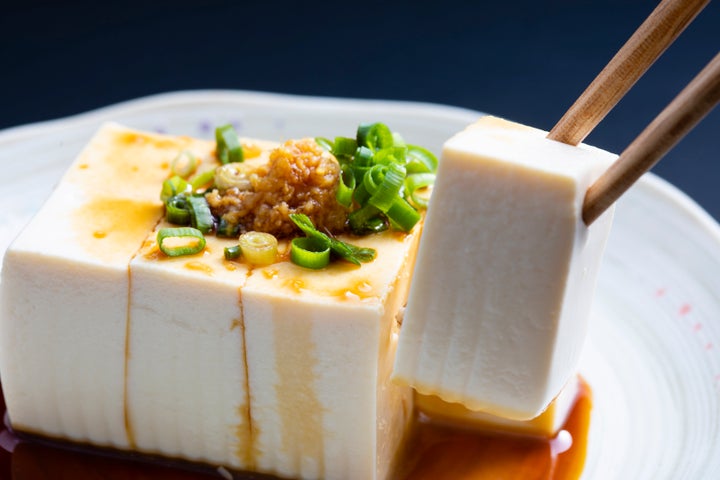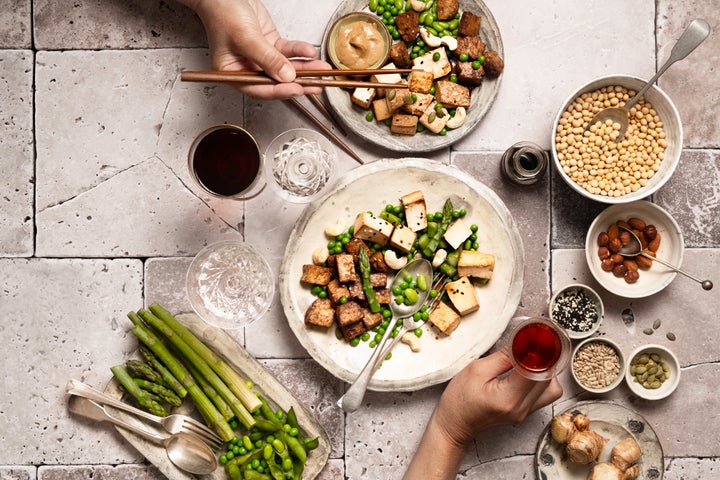
Baffled by all the types of tofu at the grocery store? Each one is perfect for something, but can wreck dinner if used in the wrong dish.
Back in the pre-internet days, 16-year-old me bought some tofu, cubed it and tossed it in a pan of sizzling veggies, only to watch in horror as my neat cubes exploded into a million slippery white bits. This was nothing like the chewy, luscious tofu at my local House of Hunan. Plenty of people would have decided then and there that tofu was not for them, but I was destined to be a food writer, so I went to the library instead.
I had bought the wrong tofu. You don’t have to make that mistake.
What exactly is tofu, anyway?
If you didn’t grow up in a tofu-loving culture, chances are you feel a bit baffled by the white cube. Water-packed, shrink-wrapped, aseptic boxed, soft, firm, which should you buy? As a chef in a natural foods deli, a cooking class instructor, and a recipe developer for five vegan and vegetarian cookbooks I’ve written, I’ve explored working with every kind I could get my hands on. I’m convinced that everyone can find a tofu dish to love, if they learn to select the “right” tofu and use it well.
A quick primer is in order. All tofu is made by cooking yellow soybeans in water, grinding the mixture into a slurry, straining it to make soy milk, then coagulating the soy milk to make it into a solid. Because tofu originated in China around 950 A.D., then spread to Japan and throughout Asia, there are multiple traditions and approaches to making and cooking with tofu. The typical American grocery store only sells a few of the myriad options in the wide world of tofu, if you’re even that lucky.
Chinese And Japanese Styles Of Tofu
The aseptic boxed tofu that fell apart in my stir-fry was Japanese “silken” tofu. Silken tofu is made by making soy milk, then mixing in a coagulant that causes the entirety of the milk to thicken like a stiff, slice-able flan. Silken tofu is treasured for its delicate, smooth texture and subtle flavour, and you’ve probably had it in miso soup at your favourite sushi place.
The tofu I was enjoying in a stir-fry at the House of Hunan was Chinese-style tofu, which is made by adding a coagulant that causes the proteins to separate from the water, forming loose clumps. The clumps, or curds, are lifted out of the water, drained and pressed into a mould. This method creates “cloud” tofu, with a spongy, dense texture. Once the tofu is formed, it is pressed to squeeze out the remaining water, and the longer it is pressed, the firmer and denser it gets. Soft Chinese tofu is pressed the least, while firm and extra firm are pressed the longest. Soft Chinese-style tofu has a curded texture, but because it’s so moist and soft, can be used like silken tofu.
The ingredients that coagulate tofu can be different, too. Commercial tofu is coagulated with gypsum (calcium sulfate), Epsom salts (magnesium sulfate), nigari (magnesium chloride) or glucono delta lactone (GDL) or a combination. Tofu makers design products that make the most of the sweetness of gypsum, slight bitterness of nigari and smooth, gelled texture of GDL.

Which Types Of Tofu To Use And When
Each type of tofu has qualities that make it perfect for certain dishes. If you are starting with a recipe, it should help you out by specifying a type of tofu. If not, remember that silken or soft tofu is delicate and fragile, and medium, firm and extra firm are sturdier.
Silken Or Soft Tofu
These types are perfect pureed for puddings, cheesecakes, salad dressings, smoothies, mayo, dips or creamy soups. They’re beloved in classic miso soup, or chilled, topped with scallions and soy sauce. They can also be coated in batter and deep fried, but are too wet and tender to shallow fry.
Medium Or Firm Tofu
These are perfect in classic stir-fries, tofu scrambles, baked marinated tofu and tofu burgers. Because they are sturdy, but not as rock hard as extra firm, you can get a good crust or sear on cubes or slices while the interior stays tender.
Extra Firm
This is perfect for grilling and making extra chewy versions of your favourite stir-fries. Extra firm is pressed to such density that you can pat it dry, brush with oil and throw it on a hot grill without breaking. People who think tofu is too mushy love this kind.
If you’ve never played around with silken tofu, below is a recipe that I’ve found to be a winner.
Creamy Tofu-Dill Dressing
This makes a thick, creamy puree that you can use as a dip for veggies or chips, or toss with cooked potatoes or green salads. If you want a more pourable dressing, simply stir in water, a little at a time, to make the desired consistency. When pureeing tofu in the food processor, make sure it is completely smooth before adding the liquids, or you may have lumps in the end.
Makes 2 cups
- 12.3 ounces (or similar) silken tofu, extra firm (1 1/2 cups mashed)
- 1 medium cucumber, peeled, seeded and chopped
- 1 teaspoon salt
- 1/2 teaspoon black pepper
- 1 clove garlic, chopped
- 1/4 cup dill pickle juice
- 1/4 cup avocado or canola oil
- 1 scallion, chopped
- 1/4 cup fresh dill weed
Place the tofu in the bowl of a food processor and process, scraping down frequently, until the tofu is very smooth. Add the garlic, salt, pepper and half of the cucumber and process again, blending until almost smooth.
With the machine running, drizzle in the pickle juice, then the oil. Scrape and process again to blend.
Add the remaining cucumber, scallion and dill and pulse to mix.
Scrape into a jar and refrigerate until time to serve.
To make in a blender, pour the pickle juice and oil in first, then add the tofu, salt, pepper, garlic, and half of the cucumber, then secure the lid and blend until smooth. Add the remaining cucumber, scallion and dill and pulse to mix.